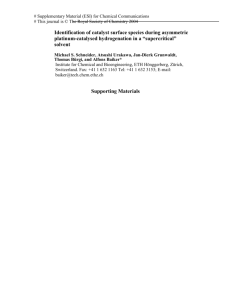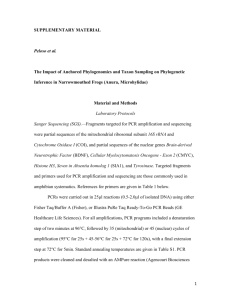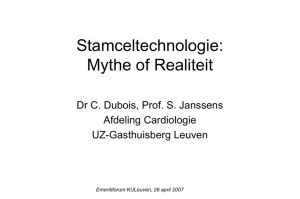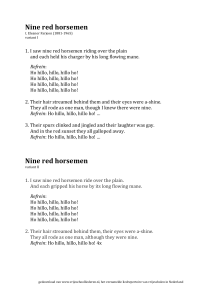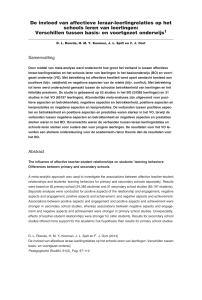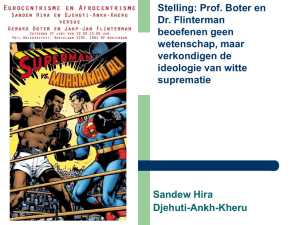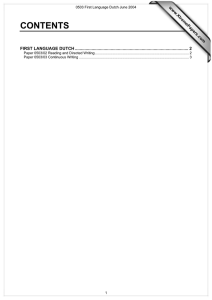Supplementary Materials and Methods (doc 94K)
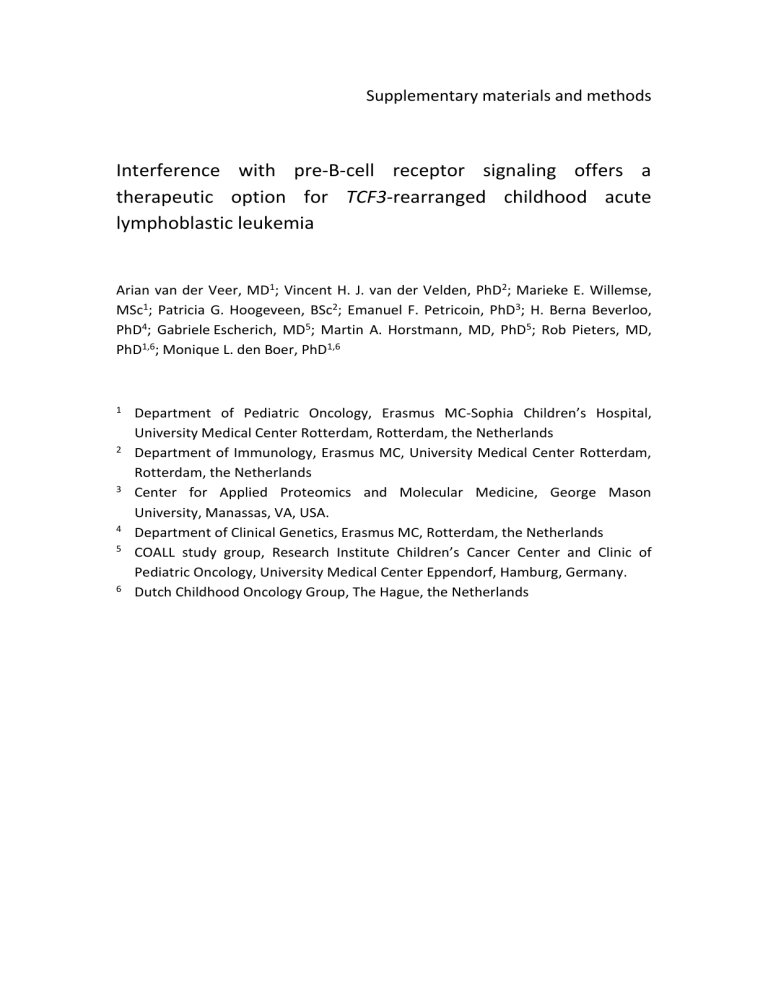
Supplementary materials and methods
Interference with pre-B-cell receptor signaling offers a therapeutic option for TCF3-rearranged childhood acute lymphoblastic leukemia
Arian van der Veer, MD 1 ; Vincent H. J. van der Velden, PhD 2 ; Marieke E. Willemse,
MSc 1 ; Patricia G. Hoogeveen, BSc 2 ; Emanuel F. Petricoin, PhD 3 ; H. Berna Beverloo,
PhD 4 ; Gabriele Escherich, MD 5 ; Martin A. Horstmann, MD, PhD 5 ; Rob Pieters, MD,
PhD 1,6 ; Monique L. den Boer, PhD 1,6
1 Department of Pediatric Oncology, Erasmus MC-Sophia Children’s Hospital,
University Medical Center Rotterdam, Rotterdam, the Netherlands
2 Department of Immunology, Erasmus MC, University Medical Center Rotterdam,
Rotterdam, the Netherlands
3 Center for Applied Proteomics and Molecular Medicine, George Mason
University, Manassas, VA, USA.
4 Department of Clinical Genetics, Erasmus MC, Rotterdam, the Netherlands
5 COALL study group, Research Institute Children’s Cancer Center and Clinic of
Pediatric Oncology, University Medical Center Eppendorf, Hamburg, Germany.
6 Dutch Childhood Oncology Group, The Hague, the Netherlands
This appendix has been provided by the authors to give readers additional information about their work.
Supplementary materials and methods
Pre-B-cell receptor in TCF3-rearranged childhood ALL
Van der Veer et al.
2
Samples
Bone marrow aspirates of newly diagnosed BCP-ALL patients (1-18 years) were collected after the patients, parents or guardians had given their written consent.
Institutional review boards approved the use of excess of diagnostic material for research purpose.
Cytogenetic abnormalities were identified in BCP-ALL cells as follows: ETV6-RUNX1- translocations were identified using real-time quantitative RT-PCR (RQ-PCR) and interphase Fluorescent In-situ Hybridization (FISH), high hyperdiploidy using conventional karyotyping (>50 chromosomes) or DNA-index (≥1.16), TCF3- rearrangements by RQ-PCR or split-signal interphase FISH, BCR-ABL1-translocations using RQ-PCR, conventional karyotyping or interphase FISH. Immunophenotyping, including CyIg expression, was performed by reference laboratories. Samples that contained >30% leukemic cells expressing CyIg
were marked as CyIg
positive. The cell lines MHH-CALL3 (TCF3-rearranged BCP-ALL), MHH-CALL4 (non-TCF3-rearranged
BCP-ALL) and Nalm6 (non-TCF3-rearranged BCP-ALL) were obtained from Deutsche
Sammlung von Microorganismen und Zellkulturen (DSMZ, Braunschweig, Germany).
The mononuclear fraction of bone marrow aspirates was isolated using Lymphoprep sucrose centrifugation (1.077 g/ml, Nycomed Pharma, Oslo, Norway). The leukemic blast percentage was determined after May-Grünwald-Giemsa staining. The blast percentage was increased >90% by depleting normal cells by anti-CD-antibody coated magnetic beads (Dynal, Oslo, Norway) as described previously.
1 DNA and RNA were isolated using TRIzol reagents (Invitrogen, Breda, the Netherlands) according to manufacturer’s protocols and dissolved in Tris-EDTA. Cell pellets containing 5 million cells were stored in -80°C upon protein isolation.
Immunoglobulin rearrangement profile
Samples were screened for the presence of IGH (V
H
-J
H
and D
H
-J
H
) and IGK-Kde (V -
Kde and intron RSS-Kde) rearrangements using genomic PCR heteroduplex analysis.
2
Supplementary materials and methods
Pre-B-cell receptor in TCF3-rearranged childhood ALL
Van der Veer et al.
3
PCR analysis of V -J and V -J rearrangements was performed using the BIOMED-2 multiplex primer-sets (IVS Technologies, San Diego, CA).
3 Based on the type and order of immunoglobulin rearrangements in normal B-cell differentiation, samples were classified as IGH (IGH rearrangements only), IGK (V -J without IGK-Kde rearrangement), IGK-Kde (IGK-Kde without V -J rearrangement), or IGL (V -J rearrangements).
Reverse phase protein array
The revere phase protein assay (RPPA) was performed as described previously.
4 Cell pellets were lysed in Tissue Protein Extraction Reagents (Pierce Biotechnology,
Rockford, IL, USA) supplemented with 300 mM NaCl, 1 mM sodium orthovanadate
(Sigma-Aldrich, Zwijndrecht, the Netherlands), 2 mM pefabloc (Roche, Almere, the
Netherlands), 5 ug/ml aprotinin (Roche), 5 ug/ml leustatin (Roche) and 5 ug/ml pepstatin (Roche). After incubation on ice, tubes were centrifuged and the supernatant was transferred to new vials. The cell lysates were spotted at 0.5 ug/ul, twice in triplicate on each slide on a glass-backed nitrocellulose-coated array slide
(FAST-slide, Whatman Plc, Kent, UK) by an Aushon Biosystems 2470 arrayer (Aushon
Biosystems, Billerica, MA, USA). The total amount of loaded protein was determined on the first of every fifteen slides by Sypro Ruby Protein Blot Stain (Invitrogen,
Bleiswijk, the Netherlands), quantified on a NovaRay CCD fluorescent scanner (Alpha
Innotech, San Leandro, CA, USA). Slides were stained with antibodies against BTK
(#3532), SLP65 (#3587) and IRF4 (#4948) obtained from Cell Signaling Technology
(Danver, MA, USA), EBF1 (#1879) from ABnova (Walnut, CA, USA), ZAP70 (#05-253) from Millipore (Billerica, MA, USA) and PI3K-p110δ from Santa Cruz Biotechnology
(Santa Cruz, CA, USA). For the incubation with the secondary antibody a DAKO cytomation (Dako, Heverlee, Belgium) autostainer was used. Slides were scanned on a NovaRay-scanner and analyzed with MicroVigene version 2.8.1.0 software
(VigeneTech, Carlisle, MA, USA). Protein levels detected by the specific antibodies
Supplementary materials and methods
Pre-B-cell receptor in TCF3-rearranged childhood ALL
Van der Veer et al.
4
were normalized for total protein levels in each sample and were corrected for background staining of the secondary antibody.
In vitro BTK-inhibition assay
Sensitivity to the BTK-inhibitor Ibrutinib (PCI-32765, Selleckchem, Houston, TX, USA) was analyzed in six TCF3-rearranged BCP-ALL cases, two hyperdiploid cases, two
ETV6-RUNX1-translocated cases, one BCR-ABL1-translocated case, one BCR-ABL1-like case and the leukemic cell lines MHH-CALL3 (TCF3-rearranged), MHH-CALL4 and
Nalm6 (both non-TCF3-rearranged). The inhibitor was dissolved in dimethylsulfoxide (DMSO). The final concentration of DMSO was 0.3%, which did not affect the viability of leukemic cells. Cells were resuspended in RPMI (Invitrogen, Life
Sciences, Bleiswijk, the Netherlands) with 20% fetal calf serum at a concentration of
2.5 million cells/ml. All tested primary patients’ samples contained ≥90% leukemic cells. The sensitivity to Ibrutinib was determined by methyl-thiazol-tetrazolium
(MTT) assays. BCP-ALL primary patients’ cells and cell lines were incubated with a serial dilution of Ibrutinib ranging between 0.6 μM and 50.0 μM, in duplicate in a 96wells plate for three days at 37°C, 5% CO
2
. Cells were incubated with the equivalent
DMSO-concentrations as control. Subsequently, 3-[4,5-dimethylthiazol-2-yl]-2,5diphenyl tetrazoliumbromide was added, as previously described.
1 After six hours, acidified propanol was used to dissolve formazan crystals and the amount of formed formazan was quantified at a wavelength of 562 nm by a VersaMax (Molecular
Devices, Sunnyval, CA, USA). Dose-response curves were generated for samples with an optimal density read of at least 100 units and more than 70% leukemic cells in the control wells left after 3 days of culture at 37°C. The percentage of viable cells at each Ibrutinib concentration was calculated by the ratio in optical density of
Ibrutinib-exposed and DMSO-exposed control wells.
Supplementary materials and methods
Pre-B-cell receptor in TCF3-rearranged childhood ALL
Van der Veer et al.
5
Detection of downstream effect of Ibrutinib by western blot
MHH-CALL3 cells, as a model for TCF3-rearranged BCP-ALL and MHH-CALL4 and
Nalm6, as a models for non-TCF3-rearranged BCP-ALL, were incubated with 0 μM, 50
μM and 150 μM of Ibrutinib for 4 hours. Cells were cultured in RPMI with 20% fetal calf serum at 37°C, 5% CO
2
. Cells were washed twice with physiologically buffered salt solution (PBS, Invitrogen, Life Sciences, Bleiswijk, the Netherlands), and resuspended in 100 μl lysis buffer. Lysis buffer contained 25 mM Tris
(tris[hydroxymethyl]aminomethane) buffer, 150 mM NaCl, 5 mM EDTA
(ethylenediaminetetraacetic acid), 10% glycerol, 1% Triton X-100, 10 mM sodium pyrophosphate, 1 mM sodium orthovanadate, 10 mM glycerolphosphate, 1 mM dithiothreitol, 1mM phenylmethylsulfonyl fluoride, 1% aprotinin (Sigma-Aldrich),
10mM sodium fluoride, and 20 μL of freshly prepared sodium pervanadate. Cells were lysed on ice for 30 minutes. Protein concentrations were measured by the bicinchoninic acid protein assay (Pierce Biotechnology, Etten-Leur, the Netherlands) with a concentration series of bovine serum albumin (BSA) as standard. Twenty ng of protein per case was separated on a precast gel ( Mini-PROTEAN TGX Gels any KD,
Biorad, Veenendaal, the Netherlands) and blotted on a nitrocellulose trans-blot
(Biorad) using the conditions recommended by the manufacturer. Antibodies against total ERK1/2 (p44/42 MAPK, #4695, Cell Signaling) and phosphorylated ERK1/2
(p44/42 MAPK (T202/Y204), #4370S, Cell Signaling) were incubated overnight at 4°C in TBS-Tween 5% BSA. Antibody against
-actin was incubated for one hour at room temperature. After washing with TBS-Tween 1% BSA, the secondary antibody was incubated for one hour at room temperature. The blots were scanned on an Odyssey
Infrared Scanner 9190 (Li-Cor, Lincoln, USA). Western blots were analyzed by
Odyssey Software 2.1.
Supplementary materials and methods
Pre-B-cell receptor in TCF3-rearranged childhood ALL
Van der Veer et al.
6
Literature
1. Den Boer ML, Harms DO, Pieters R, Kazemier KM, Gobel U, Korholz D, et al.
Patient stratification based on prednisolone-vincristine-asparaginase resistance profiles in children with acute lymphoblastic leukemia. J Clin Oncol
2003; 21(17): 3262-3268.
2. van der Velden VH, van Dongen JJ. MRD detection in acute lymphoblastic leukemia patients using Ig/TCR gene rearrangements as targets for real-time quantitative PCR. Methods Mol Biol 2009; 538: 115-150.
3. van der Velden VH, de Bie M, van Wering ER, van Dongen JJ. Immunoglobulin light chain gene rearrangements in precursor-B-acute lymphoblastic leukemia: characteristics and applicability for the detection of minimal residual disease. Haematologica 2006; 91(5): 679-682.
4. Petricoin EF, Espina V, Araujo RP, Midura B, Yeung C, Wan X, et al.
Phosphoprotein pathway mapping: Akt/mammalian target of rapamycin activation is negatively associated with childhood rhabdomyosarcoma survival. Cancer Res 2007; 67(7): 3431-3440.
Supplementary materials and methods
Pre-B-cell receptor in TCF3-rearranged childhood ALL
Van der Veer et al.
7
